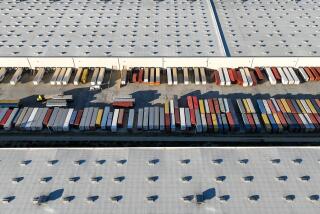Council Restricts Use of Land Near Burbank Airport : Limits: A temporary ordinance will affect about 1,000 acres, including nearly all property to be vacated by Lockheed Corp.
The Burbank City Council imposed temporary development restrictions Tuesday on land around Burbank Airport, in what city officials hope will be the first step toward converting the area to cleaner industries.
Approved by a 4-0 vote, the interim development- control ordinance buys time for city planners to make permanent zoning changes and formulate a general plan for the 1,000-acre area that stretches roughly from the airport to the Golden State Freeway between Empire Avenue and Cohasset Street.
The ordinance will affect nearly all of the 320 acres to be vacated by Lockheed Corp., which announced May 8 that it will pull much of its operation out of Burbank by the mid-1990s. The pullout of other firms that have depended on the aerospace company for business may make even more land available. City planners view the available land as an opportunity to re-create the northwestern corner of Burbank, which has been dominated by Lockheed since World War II.
âThis area is now in transition,â said William Kelly, director of community development. Councilman Michael Hastings said the city is âtrying to put clean uses there. Thatâs the whole purpose of this.â
The ordinance will require new projects in the area to go through the planned development process, which includes hearings before the planning board and the City Council, plus mailed notices to all property owners within 1000 feet of the project site.
That way, city officials can manage development in the area while they create formal controls. Without the planned development process, projects inconsistent with the cityâs plans theoretically could have slipped through, city planner Rick Pruetz said.
Pruetz said that under the ordinance, the council can reject projects that do not fit the cityâs plans for the area. Without the ordinance, he said, that would have been more difficult.
Citizens speaking at the meeting generally supported the ordinance but cautioned council members to examine carefully the future use of the land. âWhatever goes in there now, weâre going to be stuck with forever,â said Wally Berns of the Burbank Flatlanders.
In response to tougher state and federal environmental laws, Burbank officials hope to phase out heavy, polluting industries and replace them with cleaner ones. Tentative plans call for a commercial center with retail outlets concentrated along the Golden State Freeway, and research and development firms and office space closer to the airport. City officials have compared their plans to the commercial center around John Wayne Airport in Orange County.
Burbankâs current general industry zoning was adopted in 1933 and is viewed by many city officials as outdated in terms of modern environmental standards. City officials pointed out, for example, that the current regulations would allow a chromium plating shop, using hazardous chemicals, to be established without a conditional-use permit.
Proposed zoning regulations for commercial manufacturing would require issuance of a conditional use permit for any activity involving hazardous substances, which would be approved only if there was evidence that harmful impacts could be mitigated.
Projects under $50,000 are exempt from the ordinance.
Tuesdayâs ordinance will be in effect for 45 days, after which the City Council can extend it for an additional 22 months, amend it or discontinue it. That time will be used by city officials to make formal changes to Burbankâs general plan and zoning laws.
More to Read
Sign up for Essential California
The most important California stories and recommendations in your inbox every morning.
You may occasionally receive promotional content from the Los Angeles Times.










